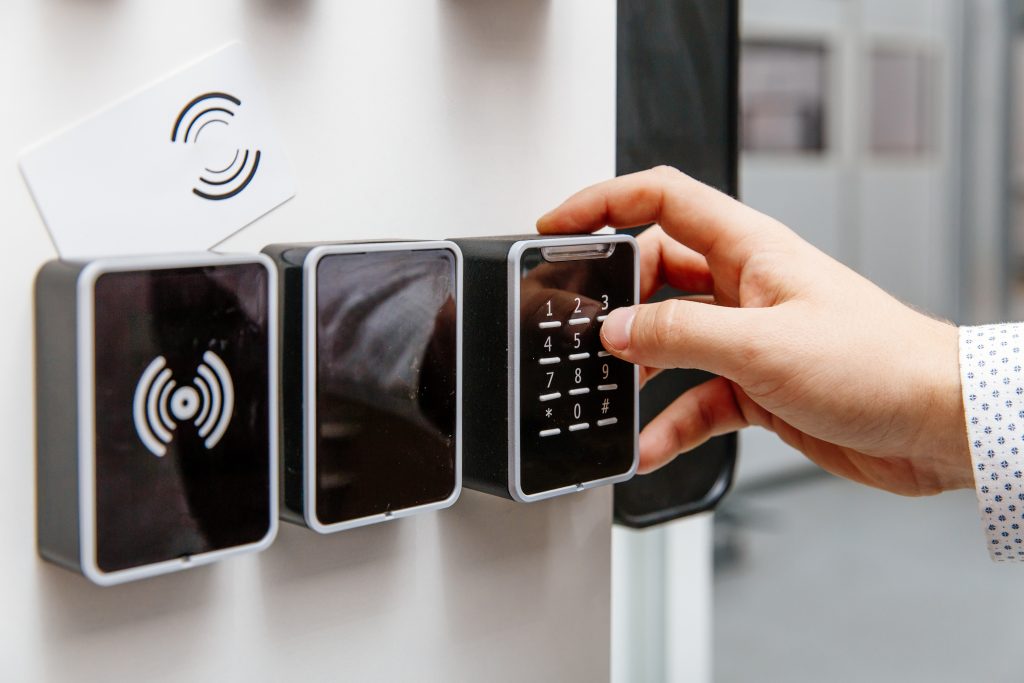Access control has become one of the most critical aspects of modern security infrastructure. Whether you manage a small office, a large enterprise, or a multi-site facility, controlling who can enter—and ensuring their identity is verified—can be the difference between a secure workplace and a costly security breach.
The evolution of Access Control has moved beyond traditional locks and keys. Today, organisations can choose from a wide range of technologies, including keycards, PIN codes, mobile access, and biometrics. Each comes with its own benefits and challenges, and the right choice depends on the needs of your facility, compliance requirements, and security priorities.

Why Access Control Matters
Physical security breaches can be just as damaging as cyber intrusions. In fact, studies show that around 30% of data breaches involve some form of physical access. Without robust access control, organisations risk theft, unauthorized data exposure, and even threats to employee safety.
Beyond security, access control also improves operational efficiency, supports compliance requirements (such as ISO 27001 and GDPR), and enables better audit trails by logging who enters and exits restricted areas.
Traditional Keycards and Fobs
Keycards and proximity fobs remain among the most widely adopted access control methods.
Advantages:
- Cost-effective and easy to implement.
- Can be programmed for specific areas or time restrictions.
- Scalable for small to large facilities.
Limitations:
- Cards and fobs can be lost, stolen, or shared.
- Vulnerable to cloning or duplication if not paired with secure technology.
- Limited in tracking advanced user behavior compared to newer methods.
Keycards work well for many organizations but may not offer the strongest protection for high-security environments.
PIN Codes and Keypads
PIN-based access is another long-standing option. Users enter a numeric code on a keypad to gain entry.
Advantages:
- No need to issue physical tokens or cards.
- Cost-effective, especially for small facilities.
- Simple to deploy across multiple access points.
Limitations:
- PINs can be easily shared or guessed.
- Codes must be updated regularly to maintain security.
- Lack of individual accountability if codes are shared.
While convenient, PIN-only systems are best suited to low-security areas or used in combination with another method.
Mobile Access Control
With smartphones becoming ubiquitous, mobile-based access control is rapidly gaining traction. Users gain entry via an app, QR code, or Bluetooth/NFC signal.
Advantages:
- Reduces reliance on physical cards or fobs.
- Convenient for users who always carry their phones.
- Supports real-time updates—access rights can be granted or revoked instantly.
- Often integrates with other workplace systems like visitor management.
Limitations:
- Dependent on the user’s device and battery life.
- Vulnerable to mobile hacking if not secured properly.
Mobile credentials are ideal for flexible, modern workplaces where employees and visitors need dynamic access.
Biometric Access Control
Biometrics—such as fingerprint scanning, facial recognition, or iris scanning—represent the most advanced access control option today.
Advantages:
- Extremely difficult to replicate or share.
- Eliminates the risk of lost cards or forgotten PINs.
- Provides the highest level of accountability and audit trails.
- Convenient for end users—no physical tokens required.
Limitations:
- Higher upfront costs for hardware and setup.
- Potential privacy concerns and data protection regulations (e.g., GDPR).
- Requires regular calibration and maintenance to ensure accuracy.
Biometrics are often the preferred solution for high-security industries such as healthcare, finance, and government facilities.
Hybrid and Multi-Factor Access
Many organisations are moving toward Multi-factor Access control, combining two or more methods such as a keycard plus PIN, or biometrics plus mobile. This layered approach significantly reduces the risk of unauthorised access while meeting compliance requirements.
Hybrid systems also allow organisations to tailor access control to different zones within the same facility. For example, general office areas may use keycards, while server rooms or labs may require biometrics.
Key Factors to Consider When Choosing an Access Control System
When selecting the best access control method for your facility, consider the following:
- Security Level Required – What is the sensitivity of the assets or information being protected?
- Scalability – Will the system accommodate future growth or additional sites?
- Compliance – Does your industry require specific security standards such as ISO 27001, GDPR, or HIPAA?
- User Experience – Will employees, contractors, and visitors find it easy to use?
- Integration – Can the system integrate with CCTV, alarms, or HR systems?
- Cost vs Value – Factor in both initial investment and long-term maintenance.
The Future of Access Control
The next wave of access control will be defined by AI and cloud integration. Intelligent systems will adapt in real-time, detecting anomalies such as unusual access times or locations. Remote management will allow administrators to monitor facilities across geographies. Biometric technologies will also become more widespread, with facial recognition and contactless identification growing in adoption.
As workplace security becomes more complex, access control will evolve into a central component of enterprise risk management, bridging the gap between physical and digital security.
Final Thoughts
From keycards and PINs to mobile and biometric solutions, access control has come a long way. The right choice depends on your facility’s unique requirements, risk profile, and budget. While traditional systems may still serve many businesses, the rise of mobile and biometric access control provides organisations with stronger security, better compliance, and improved convenience.
Contact Creative Networks Today
At Creative Networks, we help businesses design and implement tailored Access Control Solutions—whether you need secure keycard systems, mobile integration, or advanced biometric technology. Our expertise ensures your facility remains protected while delivering a seamless experience for staff and visitors.
Contact Creative Networks today to discover the best access control solution for your business.




